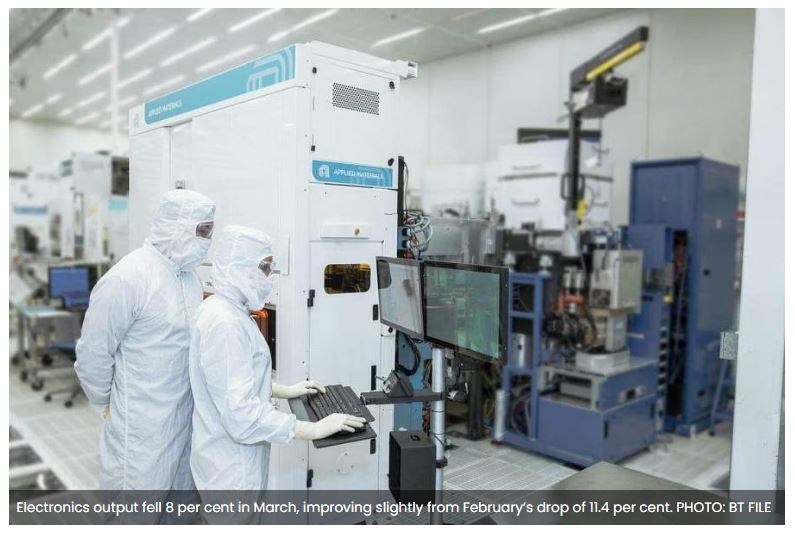Singapore factory output falls 4.2% in March in sixth month of contraction; economists expect slump to continue
SINGAPORE’S manufacturing output contracted less than expected in March, but economists expect the industry’s slump to continue for at least the first half of 2023.
Industrial production fell 4.2 per cent year on year in March, marking the sixth straight month of contraction, according to data from the Singapore Economic Development Board (EDB) on Wednesday (Apr 26).
This was an improvement from February’s revised figure of a 9.7 per cent fall, and better than the 6.1 per cent fall expected by private-sector economists in a Bloomberg poll. Excluding the typically volatile biomedical manufacturing cluster, factory output fell 6 per cent year on year in March.
Still, economists do not expect a turnaround yet. Oxford Economics senior economist Alex Holmes still predicts negative full-year manufacturing growth, with “continued softness” in the next couple of quarters as output trends further downwards.
While China’s reopening may boost its import demand, this will likely be more than offset by slowing demand from the rest of the world, as tight monetary policy weighs on growth, he said.
A turnaround may only materialise in the second half of the year, said OCBC chief economist Selena Ling. She expects industrial activity in Q2 to remain subdued, and for full-year manufacturing output to contract marginally compared to 2022.
This means there is still a risk of a technical recession for the Singapore economy, she added. But an outright recession for full-year 2023 “looks less likely if there is a moderate recovery in the global electronics cycle in the second half of 2023”.
In March, the key electronics sector experienced an 8 per cent fall in output, though this was an improvement from February’s drop of 11.4 per cent. All electronics segments fell as demand declined.
Other clusters that recorded falls were:
- Chemicals (-11.8 per cent)
- Precision engineering (-7.1 per cent)
- General manufacturing (-5.6 per cent)
Chemicals was the worst performing cluster in March, though it did better than February’s 14.8 per cent drop. Though the petroleum segment grew 12.5 per cent with higher demand for jet fuel due to rising air travel, contractions were seen in specialties (6.5 per cent), petrochemicals (20.3 per cent) and other chemicals (14.3 per cent).
The remaining two clusters experienced growth. The volatile biomedical manufacturing sector grew 7 per cent, in contrast to February’s 34.1 per cent contraction. Within this, the medical technology segment grew 18 per cent, but pharmaceuticals output fell 1 per cent. For the first quarter of 2023, biomedical manufacturing output is still down 1.8 per cent from the year-ago period.
The greatest rise was in transport engineering, with output up 23.5 per cent in an extension of February’s 22.4 per cent growth. This was on the back of a 48.4 per cent increase in marine and offshore engineering, and 22.5 per cent growth in aerospace. With the latest figures, the cluster’s output in the first quarter was up 17.7 per cent from the year-ago period.
On a seasonally adjusted month-on-month basis, Singapore’s overall manufacturing output increased 9.3 per cent in March, improving from the previous month’s 12.5 per cent contraction.
Barclays regional economist Brian Tan noted that a surge in biomedical manufacturing contributed to the partial rebound, though “the overall pick-up was not enough to fully reverse February’s contraction.”
Excluding biomedical manufacturing, production increased 5.1 per cent on the month on a seasonally-adjusted basis, in contrast to the 9 per cent contraction in February.
Given the latest March data, Tan estimated that Singapore’s first quarter gross domestic product (GDP) may see “a slightly larger pickup” than previously estimated: growth of 0.2 per cent year on year, compared to the advance estimate of 0.1 per cent.
The advance estimates had assumed a 6.0 per cent contraction in Q1 manufacturing activity, but the March figures imply a 5.6 per cent fall instead, he added.
He maintained his full-year 2023 GDP growth forecast of 1.8 per cent, in the upper half of the official 0.5 to 2.5 per cent forecast range.
Source: https://www.businesstimes.com.sg/singapore/economy-policy/singapore-factory-output-falls-42-march-sixth-month-contraction-economists


 English
English




